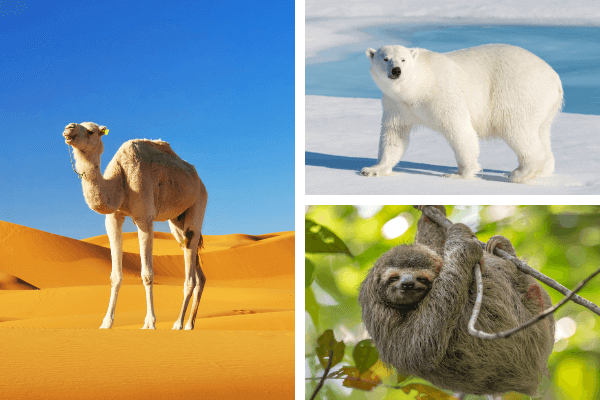
Animal Adaptations Topic Covered
➤ What is Adaptation
➤ Types of Adaptation
➤ Animal Adaptations In Deserts
➤ Animal Adaptations In Grassland
➤ Animal Adaptations In Tropical Rainforests
➤ Adaptations of Animals In Polar Regions
What is Adaptation?
Types of Adaptation
1. Physical Adaptation
Examples of physical adaptations – the thickness of an animal’s fur help them to survive in cold environments. The shape of a bird’s beak helps them to eat food as well as make nests. Camel’s long legs, eyelids, and hump are all examples of adaptation.
Animals depend on their physical structure to help them find and eat food, build shelters, protect themselves from predators and reproduce.
Some More Examples of Physical Adaptation
2. Behavioral Adaptation
DIURNALITY is the trait of an organism that is active during the day, while NOCTURNALITY describes the ones that are active during the night.
Some More Example of Behavioral Adaptation –
Some geese fly south in the fall to stay warm and find food during winter. Sloths move very slowly through trees making them hard to spot
3. Physiological Adaptation
Physiological adaptations are metabolic changes in an animal that help them to survive.
For example, A snake’s ability to produce venom, a mammal’s ability to maintain constant body temperature, the release of toxins or poisons, the release of antifreeze proteins to avoid freezing in cold environments, etc.
Animal Adaptations In Deserts
Animals that live in desert biomes have adaptations to help them to survive the harsh climate.
Let’s learn how all these animals manage to survive in such an arid environment.
How Have Camels Adapted to the Desert?
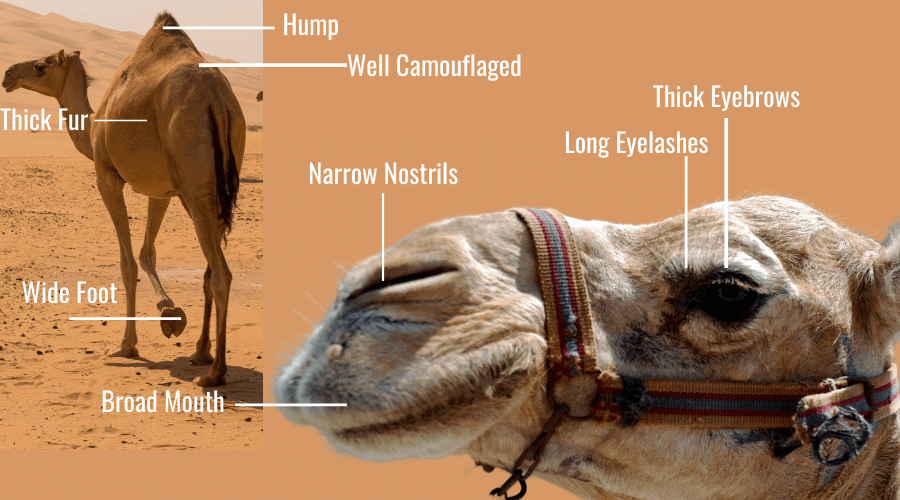
- Humps to store fat in which a camel breaks down into water and energy in the scarcity of food and water.
- Two rows of long eyelashes and thick eyebrows help them to keep out sand and desert sun.
- Narrow nostrils and hairy ears also help them to keep out sand.
- Thick and tough lips help them to pick at dry and thorny desert plants.
- Broad and flat feet, so they don’t sink in the sand and walk easily.
- They can go for a week or more without water. They can drink up to 32 gallons (46 liters) of water at one go.
- Long legs protect them from sand heat.
- Rarely sweat. Change their body temperature to avoid water loss through sweating.
- They are well camouflaged. Their body color helps them to blend into their environment.
- Thick fur helps to keep them warm at night.
How Have Tortoises Adapted to the Desert?
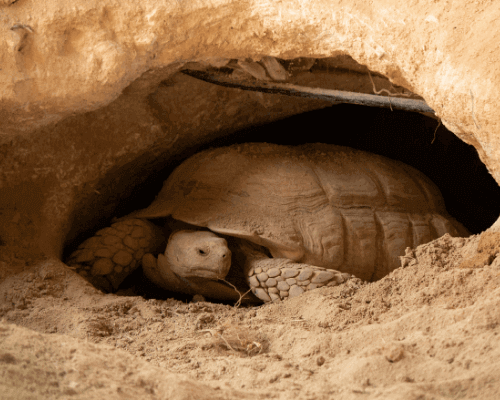
The desert tortoise has made many adaptations to its home environment.
- Desert tortoises are active mostly during the day depending on the temperature.
- They burrow under the sand to protect themselves from the intense heat in the summer and subfreezing temperatures while it is dormant in the winter.
- Desert tortoises have an oversized bladders that can carry extra water.
- In wet conditions, they excrete waste and drink extra water to store in their bladders.
- The desert tortoise has adapted to the less rainfall in the desert. To maintain its water intake, the tortoise consumes the moisture in the grasses and flowers.
- Their thick rear legs and flatter front feet help desert tortoises to walk easily in the sand.
- Tortoises can keep their head, legs, and tail in the shell, providing themselves protection against predators.
- An adult tortoise can survive a year without water.
How Have Fennec Foxes Adapted to the Desert?
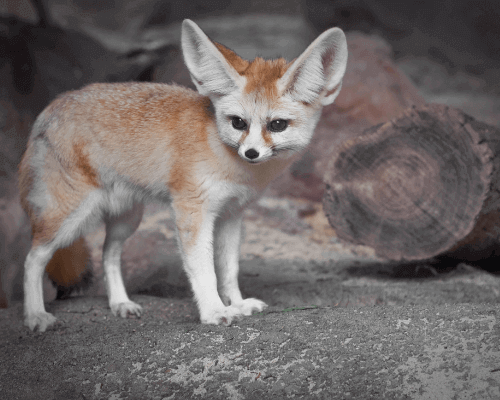
- Their distinctive large ears, which are usually 6 inches long (15 centimeters), radiate body heat and help keep the foxes cool.
- Their long, thick hair insulates them during cold nights and protects them from hot temperatures during the day.
- Fennec fox’s hairy feet perform like safety shoes, which protects them from extremely hot and cold sand.
- Their burrowing and nocturnal lifestyle help restrict water loss.
- The fox’s feet are also effective shovels for frequent digging—fennec foxes live in underground dens.
- The fennec fox can go for long periods without water. Their kidneys are adapted to restrict water loss, their extensive burrowing may cause the formation of dew, which can then be consumed, and they will receive moisture from the food that they eat.
How Have Kangaroo Rat Adapted to the Desert?
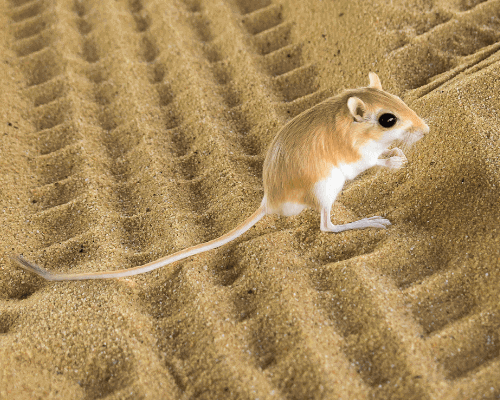
- Kangaroo Rats are nocturnal, which protects them from the heat during the day.
- Kangaroo rats dig burrows to protect themselves from predators and extreme heat.
- Kangaroo rats obtain their water from the food they eat. They can extract a half gram of water out of every gram of seeds consumed.
- They don’t even need water to bathe. Instead, they will take a dust bath by rolling around in the sand.
- They have large hind legs that allow them to jump almost 9 feet at a time to avoid predators.
- They have large ears as well as an extremely good sense of hearing that allows the rat to detect the approach of predators.
- Kangaroo rats collect seeds and beans at night and store them in their cheek pouches. This behavior allows them to store extra seeds quickly.
Animal Adaptations In Grassland
What is Grassland? The grassland biome can be found on every continent except Antarctica. The largest grasslands are located in East Africa.
Grasslands biomes are filled with grasses and wildflowers. There is very little rainfall to grow tall trees like in a forest, but they receive more rain than in a desert.
So Grasslands are generally located between deserts and forests.
Grasslands are known by different names—prairies in North America, Asian steppes, Savannahs and Veldts in Africa, Australian rangelands, pampas, llanos, and cerrado in South America.
Let us learn how some animals manage to survive in the grassland region.
How Have Black-footed ferret Adapted to the Grassland?
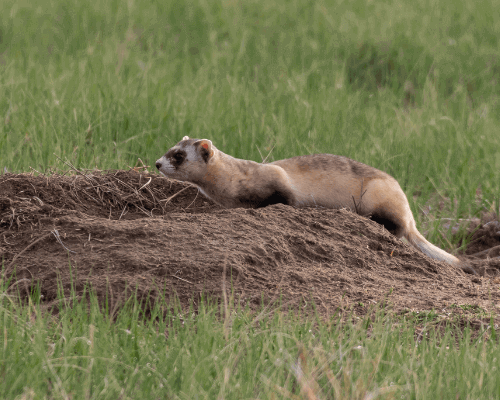
- The body color of the black-footed ferret is an adaptation for self-protection. The black-footed ferret is hard to find if they are stationary because its body color blends in with the environment.
- Their sharp claws and strong jaw help them to attack and hold onto their prey.
- Black-footed ferrets have slender bodies with sharp claws and teeth that can dig away the dirt. They have many burrows, which helps them to escape very easily when a predator is attacking them.
- The acute sense of smell helps the Black-footed ferret to sniff out prey hiding in burrows.
How Have Coyote Adapted to the Grassland?
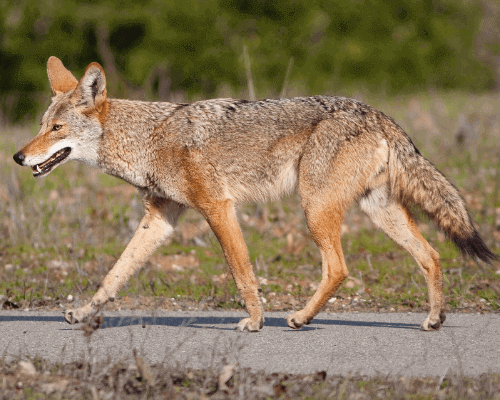
- Coyotes live in North America from Alaska to Mexico. They have an amazing sense of smell and great vision.
- Coyotes also have an amazing speed (up to 40 miles per hour) to escape predators and catch their prey.
- Their fur color helps them blend in with the many habitats they live in.
The thick fur of the coyote helps to keep it warm throughout the winter. - They are nocturnal, which means they are awake at night and sleep during the day.
How Have Bison Adapted to the Grassland?
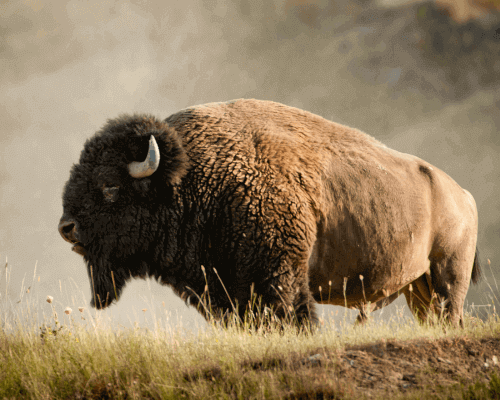
- Bison have specialized teeth and digestive systems that help in breaking down tough grass.
- Bison drink water only once a day. This adaptation helps them to keep away from water sources while grazing. They can eat snow if liquid water is not available.
- Despite their size, they are able to run up to 30 miles per hour if they are faced with a threat.
- Bison sport a pair of sharp, curved horns, which they use to fend off predators
Animal Adaptations In Tropical Rainforests
What is Tropical Rainforest? The tropical rainforest is a hot, moist biome where it rains all year long. It is abundant with many species of wildlife and vegetation. The world’s largest tropical rainforests are in South America, Africa, and Southeast Asia.
Let us learn how some animals manage to survive in the Tropical Rainforests region.
How Have Sloths Adapted to the Tropical Rainforests?
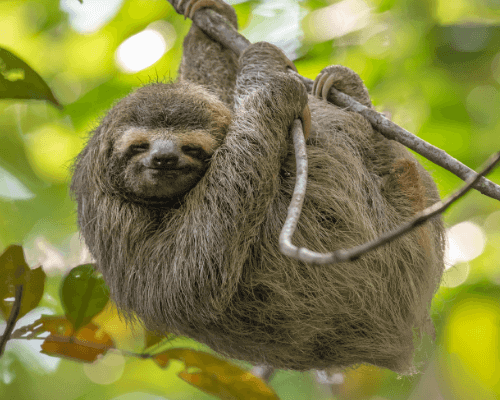
- The sloth moves very slowly, which makes it harder for predators to see them.
- Most interestingly, because of their slow movement, algae grows on their fur which helps them in camouflaging with the trees.
- They also have three extra neck bones to allow them to turn their heads at 270°. This is a very useful adaptation in a world where predators can be above or below them.
- Sloths cannot walk but are good swimmers when the rainforest floods.
- They have three extra neck bones that help them to turn their heads 270° to look over each shoulder.
- Sloths have longer arms than their legs for climbing easily and curved feet for grasping branches firmly.
- They eat leaves that are hard to digest, but their complex stomach breaks down and ferments them easily.
How Have Toucans Adapted to the Tropical Rainforests?
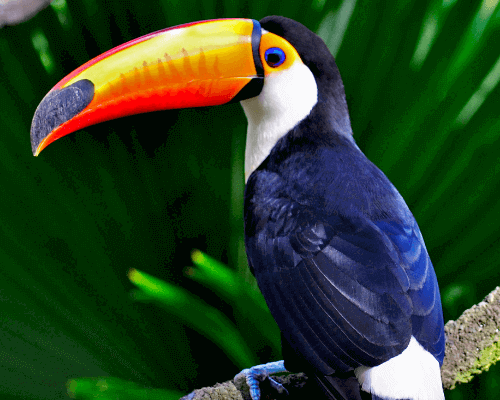
- The Toucan has a long, large, narrow but lightweight bill to allow it to reach, pick and cut fruit from branches, as the Toucan only consumes fruits that other animals and even bird species cannot access that level of the forest.
- Its bill is made up of Keratin which makes it grow so long and lightweight.
- They tuck their beak underneath their wings once they sleep to maintain heat.
- The Toucan possesses four toes on every foot, two of which face forward and two of which face backward. This adaptation gives them a better grip on branches, and perching spots, and easily climbs a tree.
- Its brightly colored feathers help it blend into its surroundings and avoid predators.
- The excellent eyesight of the Toucan helps it see predators far before they spot them, giving the keel-billed toucan time to fly into the air and stay a safe distance away from them.
Animal Adaptations In Polar Region
What are Polar Regions? The polar regions, also called the frigid zones are the coldest places on Earth. There are two main polar regions in the world, which are the Arctic and Antarctica. The North Pole is surrounded by the Arctic Ocean, and the South Pole is in Antarctica.
Animals that live in polar regions have to be well-adapted to survive the harsh environment. They often have a thick layer of fat or blubber to help keep them warm.
How Have Polar Bears Adapted to the Polar Region?
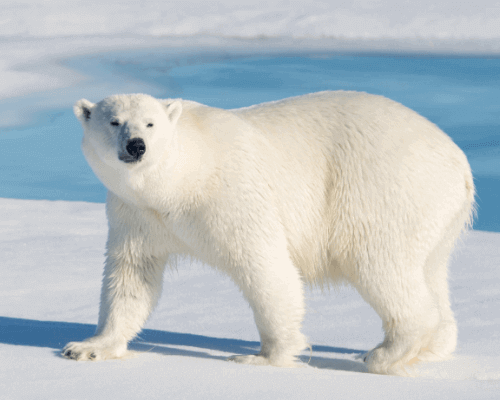
- Their white fur helps them blend in the snowy habitat.
- The thick blubber and dense fur of Polar bears help them keep warm.
- The wide, large, and bumpy paws of the polar bear help it to walk in the snow easily.
- Polar bears’ paw has webbing between their toes, which help them to swim well.
- When a polar bear swims, it closes its nostrils; because of that, no water can get in.
They need very high-fat diets in order to get energy. Polar bears have adapted well to digest high amounts of fats. - Food can be hard to come by for polar bears for much of the year, so they reserve most of their yearly fat between late April and mid-July.
The polar bear has a good sense of smell that helps it to hunt.
How Have Arctic Wolves Adapted to the Polar Region?
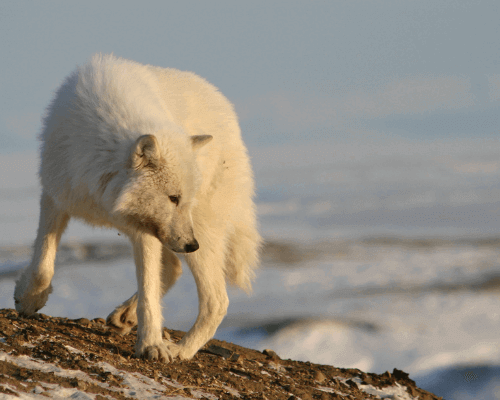
Arctic Wolves, also sometimes known as the Polar Wolf or the White Wolf, are animals of the far north. They live their whole lives above the northern tree line in the Arctic tundra of North America and Greenland.
- Arctic wolves have white fur, which helps them blend in with the environment they live in.
- Their fur is denser and longer than other subspecies. At their longest, they can grow up to about 6 feet, including their tail.
- Arctic wolves have smaller ears and shorter muzzles to contain their body heat.
- During winter, these Arctic wolves grow a second layer of fur for protection from harsh conditions.
- They have a thick, white coat that is insulated against frigid temperatures.
- The layer of fur closest to the wolf’s skin is waterproof. The waterproof layer of fur helps this wolf to remain dry and maintain its body heat in subzero temperatures.
Animal Adaptations - Vocabulary
A body part, body covering, or behavior that helps an animal survive in its environment.
Alive but in a resting condition where all body systems are very slow
